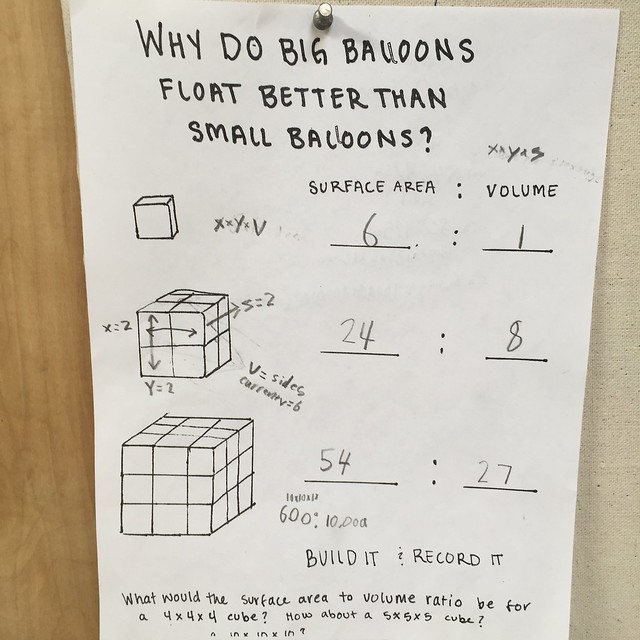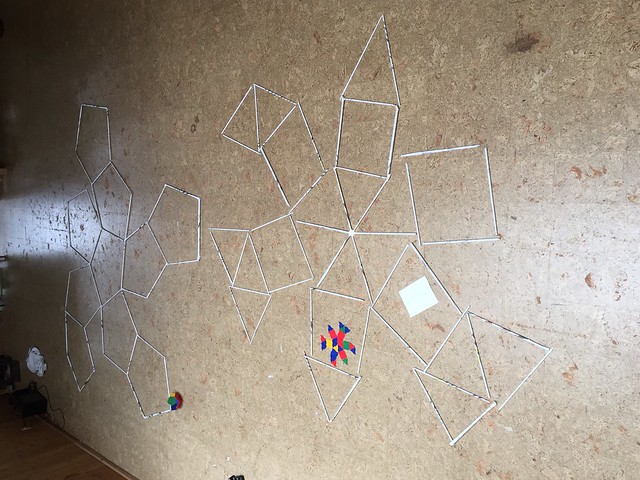The Balloon
This Friday the Blue Band's balloon rose majestically through the rafters to screams of delight from the assembled morning circle crowd. For our band it was the culmination of three weeks of exploring, experimenting and problem solving. The blue band was steeped in the physics, history and mathematics of ballooning. Inspiration for their own balloon came from this documentary about the Montgolfier brothers. Like the historians in the documentary the blue band first created a pattern for their balloon. Using snap together polygons Blue Banders created all different sorts of shapes. Sadie wears the final design on her head. The group decided upon the dodecahedron because it was simple and held the most air.
Using snap together polygons Blue Banders created all different sorts of shapes. Sadie wears the final design on her head. The group decided upon the dodecahedron because it was simple and held the most air. We ran some experiments to try to and better understand the problems we might face. The blue banders were given a table full of plastic bags and a blow dryer as a heat source.
We ran some experiments to try to and better understand the problems we might face. The blue banders were given a table full of plastic bags and a blow dryer as a heat source. What they discovered was rather counter intuitive. Everyone hypothesized that the small bags would float better because they were lighter but in fact the group found that it was the larger plastic bags that floated better when filled with hot air. Ramses and Lily are filling the largest bag with hot air.
What they discovered was rather counter intuitive. Everyone hypothesized that the small bags would float better because they were lighter but in fact the group found that it was the larger plastic bags that floated better when filled with hot air. Ramses and Lily are filling the largest bag with hot air. To try to understand why big balloons float better than small balloons the Blue Band turned to mathematical modeling.
To try to understand why big balloons float better than small balloons the Blue Band turned to mathematical modeling. This problem was definitely a stretch. Very few in the band had encountered volume problems before.
This problem was definitely a stretch. Very few in the band had encountered volume problems before. For some building cubes was a nice juicy challenge. Others ran with the problem and discovered that in smaller cubes surface area was greater than volume and in larger cubes volume was larger than surface area.
For some building cubes was a nice juicy challenge. Others ran with the problem and discovered that in smaller cubes surface area was greater than volume and in larger cubes volume was larger than surface area. When the volume is larger than surface area less heat escapes and there is more buoyant air than heavy material. We learned from Evan that the advantage of a high volume to surface area ratio is why whales and other sea creatures are so big. There is such poetry in this idea. I envision balloons like gentle beasts swimming through the air and whales flying through the sea. After all, we learned in this short documentary that balloons float in air for much the same reasons as other objects float in water.
When the volume is larger than surface area less heat escapes and there is more buoyant air than heavy material. We learned from Evan that the advantage of a high volume to surface area ratio is why whales and other sea creatures are so big. There is such poetry in this idea. I envision balloons like gentle beasts swimming through the air and whales flying through the sea. After all, we learned in this short documentary that balloons float in air for much the same reasons as other objects float in water. So the Blue Band had to figure out how to make their shape BIG! They used newspaper rolled into rods and cut to equal length to scale up the design. Tamasen is taping together the edges of her pentagon. She and her team are laying out the flat pattern for the dodecahedron design. Recreating this design at scale was a great spatial reasoning challenge.
So the Blue Band had to figure out how to make their shape BIG! They used newspaper rolled into rods and cut to equal length to scale up the design. Tamasen is taping together the edges of her pentagon. She and her team are laying out the flat pattern for the dodecahedron design. Recreating this design at scale was a great spatial reasoning challenge. When Gita, Soleil and Lily's team attempted to assemble their polyhedron they discovered that while the triangles were pretty sturdy the rest of the shapes flopped around like crazy.
When Gita, Soleil and Lily's team attempted to assemble their polyhedron they discovered that while the triangles were pretty sturdy the rest of the shapes flopped around like crazy. When all of the shapes were assembled we realized we had a bit of a problem. Not only were these floppy shapes hard to store, the patterns wouldn't fit onto the plastic sheeting. So the band went back to the drawing board.
When all of the shapes were assembled we realized we had a bit of a problem. Not only were these floppy shapes hard to store, the patterns wouldn't fit onto the plastic sheeting. So the band went back to the drawing board. We've been reading chapters from the wonderful book Problem Solving 101 by Ken Watanabe. He gives all sorts of great problem solving tools and is a big fan of finding the root problem. Instead of spending tons of time trying to tape together broken patterns and cutting endless shapes from plastic, we sat back and tried to redefine our problem statement. Instead of trying to solve the problem: "How do we cut out this big pattern?" We started trying to solve this problem: "How do we cut out 12 pentagons?"
We've been reading chapters from the wonderful book Problem Solving 101 by Ken Watanabe. He gives all sorts of great problem solving tools and is a big fan of finding the root problem. Instead of spending tons of time trying to tape together broken patterns and cutting endless shapes from plastic, we sat back and tried to redefine our problem statement. Instead of trying to solve the problem: "How do we cut out this big pattern?" We started trying to solve this problem: "How do we cut out 12 pentagons?" Building off of each others ideas the band came up with a plan. The band decided to fold the plastic. We figured out how many times we would have to fold the plastic to get 12 hexagons.
Building off of each others ideas the band came up with a plan. The band decided to fold the plastic. We figured out how many times we would have to fold the plastic to get 12 hexagons. They traced a single pentagon on the folded plastic and with one effortless cut created 12 identical pentagons that could be taped together.
They traced a single pentagon on the folded plastic and with one effortless cut created 12 identical pentagons that could be taped together. With the balloon envelope taken care of, the Blue Band tackled it's next problem: The heat source. Experimenting with the hair dryer convinced everyone that we would be needing a stronger heat source to lift our balloon. The group got brainstorming.
With the balloon envelope taken care of, the Blue Band tackled it's next problem: The heat source. Experimenting with the hair dryer convinced everyone that we would be needing a stronger heat source to lift our balloon. The group got brainstorming. Fire is a pretty dangerous element to be working with. The group had to come up with a safety plan. We mapped out all possible hazards and did our best to neutralize them.
Fire is a pretty dangerous element to be working with. The group had to come up with a safety plan. We mapped out all possible hazards and did our best to neutralize them. In order to protect our hands and the balloon material from falling on the fire the band came up with the idea of a protective tube lined with nonflammable material. Isaac dubbed this the fire tunnel.
In order to protect our hands and the balloon material from falling on the fire the band came up with the idea of a protective tube lined with nonflammable material. Isaac dubbed this the fire tunnel. Finally the Blue Banders donned their fire protective gloves and jackets to test their balloon!
Finally the Blue Banders donned their fire protective gloves and jackets to test their balloon! The first test revealed some important adjustments that needed to be made. The blue band had something that worked but needed to be tinkered with![playlist type="video" ids="4555"]The Blue Band split up into two teams. One team used scales to create a system to weight the bottom of the balloon. The other team was tasked with making the opening at the bottom of the balloon smaller. They cut out 5 trapezoids that were taped to the bottom of the balloon.This project has been such a wonderful vehicle for learning all of the most important lessons of project work. Set clear goals, make several iterations, play with your materials, when things aren't working sit back and redefine the problem statement and finally tinker! These kids were curious, perseverant and fabulous at collaborating with each other. The way they encouraged each other and snapped ideas together was a beautiful thing to behold. What a dream team!
The first test revealed some important adjustments that needed to be made. The blue band had something that worked but needed to be tinkered with![playlist type="video" ids="4555"]The Blue Band split up into two teams. One team used scales to create a system to weight the bottom of the balloon. The other team was tasked with making the opening at the bottom of the balloon smaller. They cut out 5 trapezoids that were taped to the bottom of the balloon.This project has been such a wonderful vehicle for learning all of the most important lessons of project work. Set clear goals, make several iterations, play with your materials, when things aren't working sit back and redefine the problem statement and finally tinker! These kids were curious, perseverant and fabulous at collaborating with each other. The way they encouraged each other and snapped ideas together was a beautiful thing to behold. What a dream team!
